Today, we focus on Software-as-a-Service (SaaS) companies, guiding you through the process of digital marketing for SaaS. Buckle up as we help you navigate this journey!
The SaaS industry, with its boundless B2B and B2C possibilities, has reshaped business operations. However, the rise in competition makes it crucial for SaaS companies to standout and connect effectively with their target audience. Welcome to the world of SaaS digital marketing.
Understanding SaaS Digital Marketing
As per report from Gartner, SaaS industry will reach nearly to $600 billion. Every SaaS business wants bigger piece of the cake, and here digital marketing for SaaS becomes important. SaaS digital marketing is about promoting and selling SaaS products across various digital platforms. The strategies for SaaS companies deviate from traditional methods. They aim to sell a continuously valuable service rather than a product.
Now, remember, SaaS products aren’t physical items; they exist in the cloud. So, selling something customers can’t touch or see can be complex. An effective digital marketing strategy for SaaS companies comes into play here, ensuring you provide enough valuable information to persuade potential customers.
Designing Your Digital Marketing Strategy – Here’s How
Screenshot Suggestion: Diagram or flowchart depicting the steps to create a digital marketing strategy
Developing an effective SaaS digital marketing strategy entails focusing on these key components:
- Understand Your Market: Understand your customers’ pain points and needs. Determine how your SaaS product can offer a solution. An in-depth market study should be your first step.
- Set Clear Goals: Define your digital marketing goals. Whether you want to increase website traffic, subscriptions, or brand awareness, these goals will steer your strategy.
- Pick the Right Platform: Different digital platforms cater to different audiences. Identify where your potential customers are most active and direct your resources there.
- Create Engaging Content: From blog posts and infographics to webinars and eBooks, captivating content is essential for positioning your company as an industry leader and educating your audience about your product.
- Leverage Search Engine Marketing (SEM): Utilizing both Search Engine Optimization (SEO) and Pay-Per-Click (PPC) advertising can help your business rank higher in search results, improving your product’s visibility.
- Harness the Power of Social Media: Use social media platforms to engage with your audience directly, share updates, handle customer queries, and gather valuable feedback.
- Analyze Data: Digital marketing provides a wealth of data. Analyze it to gain insights into your campaign’s effectiveness and optimize future efforts.
Digital Marketing for SaaS Starts – Time to Execute
Screenshot Suggestion: A checklist of the below strategies with tick boxes
Now that you’ve built your strategy, it’s execution time. Here are some proven digital marketing strategies for SaaS companies, let’s dive into all seven mentioned above
Understand Your Market
When we say “Understand Your Market,” we mean conducting an in-depth analysis of your target market to understand your potential customers’ needs, behaviors, and pain points. This is crucial for creating an effective digital marketing strategy for SaaS companies. Here’s a step-by-step guide on how you can achieve this:
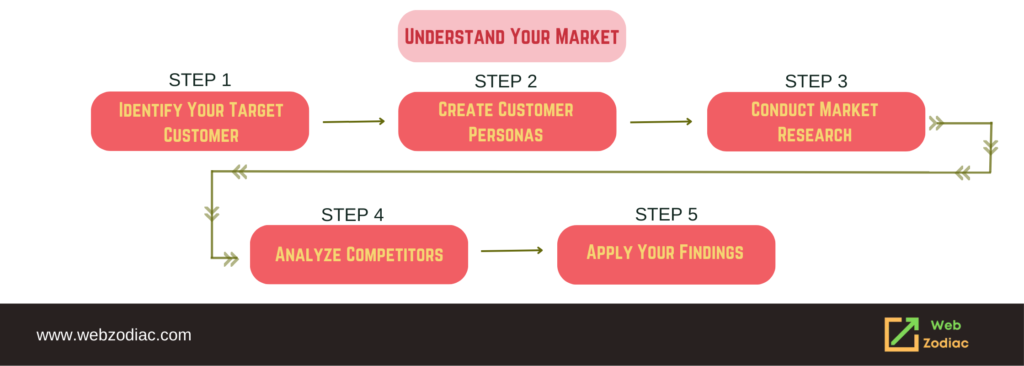
Step 1: Identify Your Target Customer
The first step in deciphering your market is identifying your target customer. This should be the typical user of your SaaS product. You can determine this based on various factors such as:
- Age
- Gender
- Geographic location
- Industry or profession

Screenshot Suggestion: A demographic profile of a target customer.
Example: For instance, if your SaaS product is a project management tool designed for remote teams, your target customer might be middle-aged professionals who manage or are part of remote teams across various industries.
Step 2: Create Customer Personas
Next, create detailed customer personas. These are fictional characters that represent your typical customers. They are based on the demographic data you gathered, as well as additional factors like:
- Interests
- Preferences
- Buying behavior
- Pain points
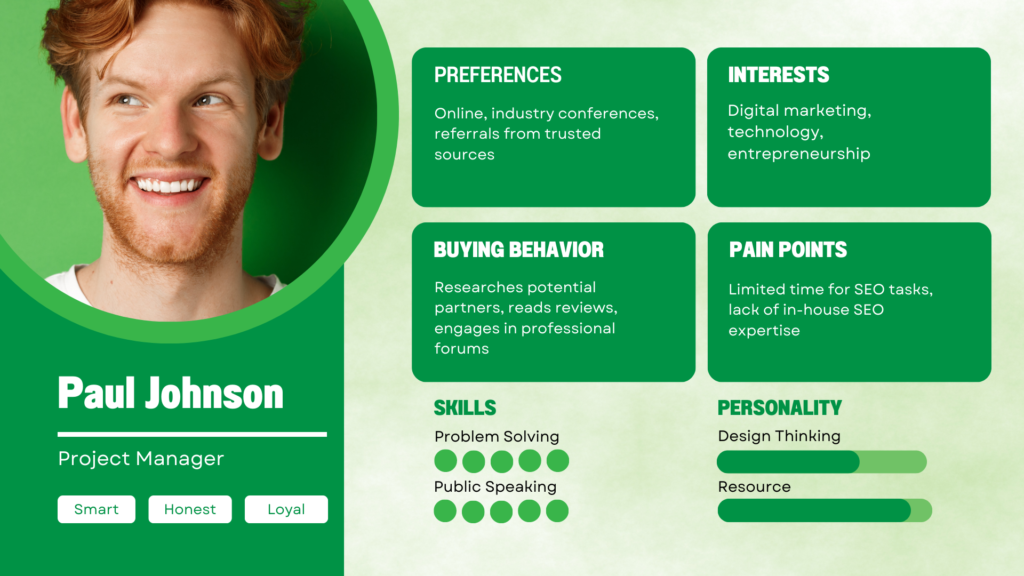
Screenshot Suggestion: An example of a detailed customer persona.
Example: In the case of our project management tool, one persona could be “Project Manager Paul”, a 35-year-old professional who struggles with managing his remote team and is looking for a tool to streamline communication and project tracking.
Step 3: Conduct Market Research
Once you have a clear understanding of your target customers, the next step is conducting market research to gain deeper insights into your market. You can:
- Survey potential customers
- Conduct focus groups
- Research industry trends and forecasts

Example: You could conduct a survey asking remote teams about their biggest challenges in project management, which features they consider essential in a project management tool, and what they don’t like about the current solutions they are using.
Step 4: Analyze Competitors
Understanding your competition is a critical part of deciphering your market. Look at your competitors’ SaaS products and marketing strategies. Identify their strengths and weaknesses and consider how your product can stand out.

Screenshot Suggestion: A SWOT analysis of a competitor.
Example: If you find that a common complaint about your competitor’s project management tool is its complicated interface, you could focus on offering a more user-friendly solution.
Step 5: Apply Your Findings
Finally, use the insights gained from these steps to tailor your SaaS digital marketing strategy to your target market. This will ensure that your marketing efforts are effectively aligned with your potential customers’ needs and preferences.
Example: Based on your market research, you might find that your target customers prefer a straightforward, no-frills project management tool that prioritizes ease of use. You can use this information to guide your product development and marketing messages.
Remember, understanding your market is an ongoing process. As your business grows, your market may evolve, and it’s important to continually update your market understanding and adapt your strategies accordingly.
Content Marketing
Content marketing is a powerful tool that SaaS companies can leverage to provide value, establish authority, and engage their audience. Here are some actionable steps you can take:

Step 1: Develop a Content Calendar
Planning is an essential aspect of content marketing. Develop a content calendar outlining when and what you will post. This helps maintain a consistent content schedule, keeps your team on track, and ensures you have a diverse range of content.

Step 2: Diversify Your Content
Different types of content appeal to different audiences and serve different purposes. Here are some formats you could consider:
- Blog Posts: Great for SEO, driving traffic to your website, and providing detailed information.
- Case Studies: Showcase how your SaaS product has helped customers. This builds trust and demonstrates real-world applications of your product.
- Webinars: Host live sessions to interact with your audience, provide in-depth knowledge, and showcase your product.
- eBooks or Whitepapers: Long-form content can establish your authority in the industry and provide immense value to your audience.
- Infographics: These can simplify complex data and make it more digestible and engaging.
Step 3: Optimize Your Content for SEO
Use keyword research to identify the terms your target audience is searching for, and incorporate these into your content. This will help improve your search engine rankings and increase your visibility. You will find more about SEO later in this article
Step 4: Promote Your Content
Creating content is just half the battle; you also need to promote it. Share your content on social media, send it in your email newsletters, and encourage your team to share it on their networks.
Step 5: Encourage Engagement
Invite your audience to engage with your content. This could be through asking for comments, promoting social shares, or including calls-to-action (CTAs) in your content. Engagement not only improves your SEO but also fosters a relationship with your audience.
Step 6: Measure and Refine
Finally, measure the success of your content marketing efforts. Are you reaching your target audience? Are they engaging with your content? Use tools like Google Analytics to track key metrics and refine your strategy as needed.
Keep an eye on following KPIs:
- Website Traffic: The number of people visiting your site after reading your content can give you an idea of its effectiveness.
- Time Spent on Page: This can help you understand how engaging your content is.
- Social Shares: The number of shares can indicate how valuable your audience found your content.
- Conversion Rate: The percentage of content viewers who complete a desired action, such as signing up for a trial.
Content marketing is an ongoing process that requires constant learning and adapting. By understanding your audience, diversifying your content, and continuously measuring your success, you can create a robust content marketing strategy that propels your SaaS company forward. So, get out there and start creating!
Social Media Marketing
Social media marketing refers to using social media platforms to promote your product, engage with your audience, and build your brand’s online presence. This is particularly crucial for SaaS companies, as it enables you to directly interact with potential and existing customers.
Here’s a step-by-step guide on how you can utilize social media marketing:
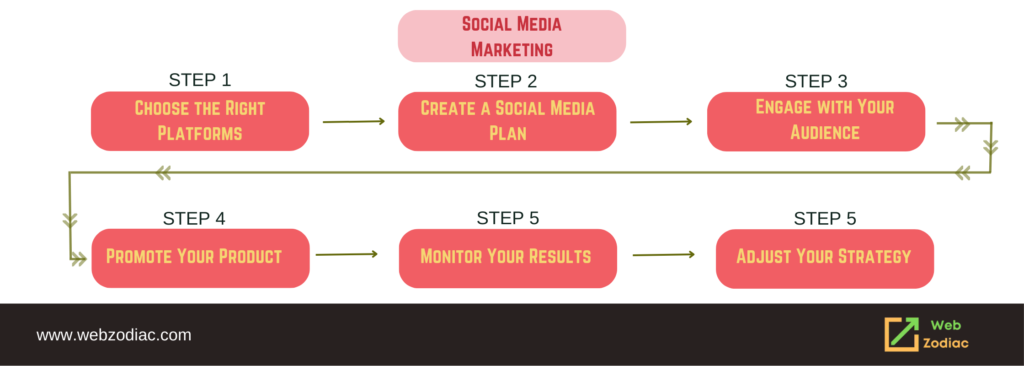
Step 1: Choose the Right Platforms
Not every social media platform is suitable for every business. You need to identify which platforms your target audience uses the most. Conduct surveys, research, or use social media analytics tools to understand where your potential customers spend their time.
Screenshot Suggestion: Chart showing different demographics’ preferred social media platforms.
Example: If your SaaS product targets young professionals, platforms like LinkedIn and Instagram might be your best bet.
You might still have 1 question, how to the choose platform?
Great question! Choosing the right social media platforms is a critical first step in your social media marketing strategy. It’s important to focus your efforts where they will have the most impact. Here are some criteria you should consider:
Target Audience Presence
One of the key factors to consider is where your target audience is most active. Different demographic groups tend to prefer different social media platforms. For example, if your target audience is young adults, you might lean towards Instagram or Snapchat. If you’re targeting professionals or businesses (B2B), LinkedIn would be a suitable choice.
Content Format
Consider the type of content that you will be sharing and which platform best supports that format. If your strategy heavily involves video content, YouTube or TikTok might be ideal. For image-heavy content, consider Instagram or Pinterest. If you plan to share industry-related articles and news, LinkedIn or Twitter could be more appropriate.
Engagement Opportunities
Some platforms offer more opportunities for engagement than others. For example, Instagram and Facebook have a variety of features that can facilitate interaction with your audience, such as polls, live videos, and Stories.
Business Features
Look at the business-specific features that each platform offers. For instance, LinkedIn allows for B2B networking and recruitment, Instagram offers shoppable posts, and Facebook has comprehensive ad targeting options.
Resource Requirements
Different platforms require different levels of resources. For example, producing high-quality YouTube videos can be resource-intensive, while tweeting on Twitter is comparatively less demanding. Consider your resources and where they can be best utilized.
Competitor Activity
It’s also worth considering where your competitors are active and seeing success. You don’t necessarily have to be present on every platform that your competitors are, but it can provide useful insights.
To determine the right platforms, you may need to do some research. Conduct audience surveys, look at industry trends, and consider testing different platforms to see where you get the best engagement. Ultimately, the best platforms for your business will depend on your specific audience, goals, and resources.
Step 2: Create a Social Media Plan
Once you’ve chosen your platforms, create a plan detailing what type of content you’ll post, how often, and at what times. This will depend on your audience’s preferences and the nature of each platform.

Example: For LinkedIn, you might focus on sharing informative blog posts and industry news, whereas on Instagram, you might share more casual updates and behind-the-scenes peeks at your team.
Step 3: Engage with Your Audience
Social media isn’t just about broadcasting your message, it’s about fostering dialogue. Respond to comments, ask for feedback, and create posts that encourage engagement.
Example: You could host a Q&A session on Instagram Stories or a Twitter chat around a relevant topic, inviting your followers to participate.
Step 4: Promote Your Product
Social media is a great platform to promote your SaaS product, but remember to strike a balance. Your audience doesn’t want to see constant sales pitches. Aim for an 80/20 ratio where 80% of your content provides value and only 20% is promotional.
Example: You could promote a new feature update on LinkedIn by explaining its benefits and how users can implement it.
Step 5: Monitor Your Results
Use social media analytics to track your performance. This includes metrics like follower growth, engagement rate, and website traffic from social media.
KPIs to focus are:
- Engagement: The number of interactions (likes, comments, shares) your social media posts receive.
- Followers Growth: The rate at which your number of followers is increasing.
- Reach: The number of unique users who see your posts.
- Conversions: The number of desired actions (like website visits, sign-ups, purchases) completed as a result of your social media activities.
Example: If you notice that your Instagram posts get much more engagement than your LinkedIn posts, you might decide to focus more of your efforts on Instagram.
Step 6: Adjust Your Strategy
Based on the insights from your analytics, make necessary adjustments to your strategy. This could mean changing up your content, posting at different times, or even switching your focus to a different platform.
Example: If your Q&A sessions are particularly popular, you might decide to make them a regular event.
Remember, social media marketing requires consistent effort and engagement. Stay active, responsive, and open to change, and you’ll start to see the benefits unfold.
Search Engine Marketing
Search engine marketing comprises of SEO and PPC. In simple words, any marketing done on search engines via search engine result pages (SERPs) is called Search Engine Marketing.

SEO (Search Engine Optimization)
SEO involves improving your website’s visibility in organic search engine results. This is a long-term strategy that can provide sustainable growth. Here’s an actionable guide:
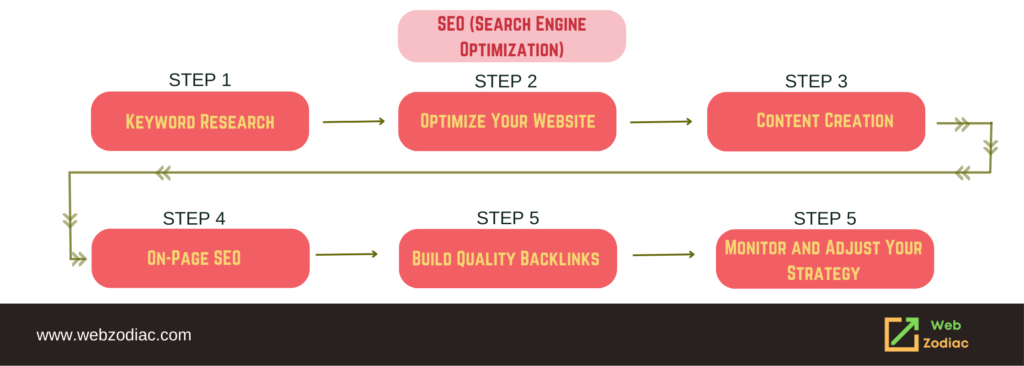
Step 1: Keyword Research
Identify the keywords relevant to your SaaS product that your target audience is likely to search for. Use tools like Google Keyword Planner or SEMRush for this purpose.
Learn More – SEO Keyword Research: What, How and Why
Example: For a CRM tool, potential keywords could be “CRM software for small businesses” or “how to manage customer relationships.”
Step 2: Optimize Your Website
Ensure your website is easy for both users and search engine crawlers to navigate. This includes a logical site structure, fast loading speed, mobile-friendly design, and secure (HTTPS) connection.
Step 3: Content Creation
Develop high-quality content based on your identified keywords. This could be in the form of blog posts, white papers, webinars, etc. Remember to use your keywords naturally and provide valuable information to users.
Step 4: On-Page SEO
Ensure each page on your website is optimized for search engines. This includes optimizing title tags, meta descriptions, and images, using keywords in your content, and creating a SEO-friendly URL structure.
Learn More – On-Page SEO: What, Why and How of Onsite Optimization
Step 5: Build Quality Backlinks
Backlinks from reputable sites can significantly improve your website’s SEO. Consider strategies like guest blogging, influencer partnerships, or PR campaigns to earn these links.
Learn More – Link Building: A Comprehensive Guide to Effective Link Building Strategies
Step 6: Monitor and Adjust Your Strategy
Use an SEO analytics tool to monitor your site’s performance and make necessary adjustments. Look at metrics like organic traffic, bounce rate, and conversion rate.
KPIs to monitor in SEO
- Organic Traffic: The number of visitors coming to your site from unpaid search results.
- Keyword Rankings: How your website ranks on search engines for targeted keywords.
- Bounce Rate: The percentage of visitors who leave your site after viewing only one page. A high bounce rate might indicate irrelevant or poor-quality content.
- Pages per Session: The average number of pages a visitor views during a single session. More pages could suggest more engaging content.
Tools – Google Analytics and Google Search Console
In case you’re looking for an experienced SEO agency you can always come to us for get SEO services for SaaS.
PPC (Pay-Per-Click)
PPC involves paying for ad placement in search results. It can provide immediate visibility and is especially useful for competitive keywords. Here’s an actionable guide:
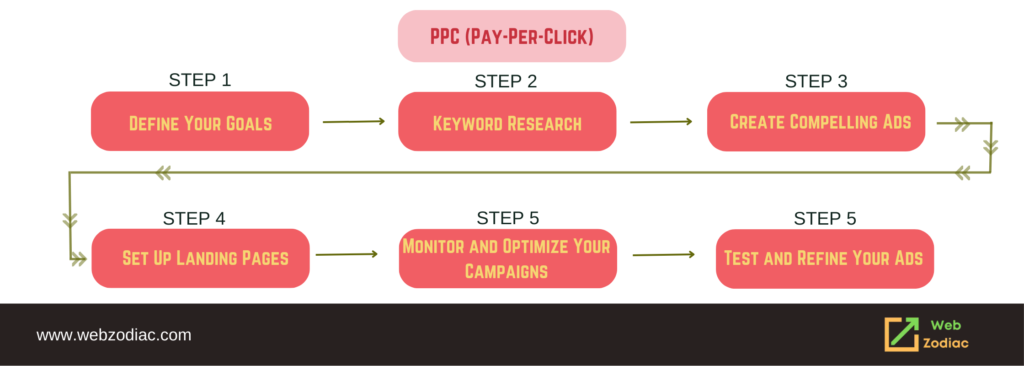
Step 1: Define Your Goals
Decide what you want to achieve with your PPC campaign. This could be increased website traffic, more sign-ups, or higher sales.
Step 2: Keyword Research
Identify the keywords you want to bid on. These should be relevant to your SaaS product and be terms that your target audience will search for. Use a tool like Google Keyword Planner to help.
Step 3: Create Compelling Ads
Write ad copy that accurately describes your product and entices users to click. Include your target keyword in the copy.
Step 4: Set Up Landing Pages
Create landing pages that users will be directed to when they click on your ads. These should provide more information about your product and encourage users to take a specific action, like signing up for a trial.
Step 5: Monitor and Optimize Your Campaigns
Use a tool like Google Ads to monitor your campaign performance. Look at metrics like click-through rate (CTR), cost-per-click (CPC), and conversion rate.
Step 6: Test and Refine Your Ads
Regularly test different aspects of your ads (like headlines or CTA) to see what performs best. Use these insights to refine your ads and improve your campaign performance.
Screenshot Suggestion: A/B test results showing performance of different ad versions.
Remember, while SEO and PPC are different strategies, they work best when used together. SEO provides long-term visibility, while PPC can help you quickly capitalize on opportunities or competitive keywords.
You can also check our blog on SEO vs PPC: Who is Winning the Powerful Debate
Email Marketing
Email marketing is a highly effective digital marketing strategy that involves sending emails to prospects and customers. It’s a great way to build relationships, keep your brand top of mind, and drive conversions. Here’s a step-by-step actionable guide to effective email marketing for your SaaS business:

Step 1: Build Your Email List
Start collecting email addresses from interested prospects. You can do this through various methods, such as offering a free resource (eBook, whitepaper) in exchange for an email address, encouraging website visitors to sign up for your newsletter, or offering a free trial of your SaaS product.
Example: You might offer a free guide on “How to Improve Customer Relationships” in exchange for an email address.
Step 2: Segment Your Email List
Categorize your subscribers based on certain characteristics like their stage in the buyer’s journey, industry, or behavior on your website. This allows you to send more personalized and relevant emails.
Example: You might segment your list into “free trial users,” “paying customers,” and “prospects.”
Step 3: Plan Your Email Campaigns
Decide on the types of emails you’ll send. This could include newsletters, promotional emails, announcements, or educational content. Align your email content with your overall marketing goals and the needs of each segment.
Example: You might send educational content about using your CRM tool to prospects, and exclusive offers or product updates to paying customers.
Step 4: Create Engaging Email Content
Craft emails that provide value to your subscribers. Use compelling subject lines to improve open rates, include clear and concise copy, and add a strong call-to-action (CTA).
Example: Your email might include a subject line like “Boost Your Sales with Our Latest CRM Feature!”
Step 5: Test and Optimize
Use A/B testing to optimize your email campaigns. Test different elements such as subject lines, email copy, CTAs, or send times, and refine based on the results.
Example: You might test two different subject lines to see which one results in higher open rates.
Step 6: Measure Your Success
Track key metrics like open rate, click-through rate (CTR), conversion rate, and unsubscribe rate to measure the effectiveness of your email marketing. Use these insights to continually improve your campaigns.
Example: If you notice a high unsubscribe rate, it might indicate that you’re sending emails too frequently or that your content isn’t resonating with your audience.
By following these steps, you can create an effective email marketing strategy that nurtures relationships, educates your audience, and drives conversions for your SaaS product. It’s a highly direct and personal way to reach your audience, making it a powerful tool in your digital marketing toolkit.



0 Comments